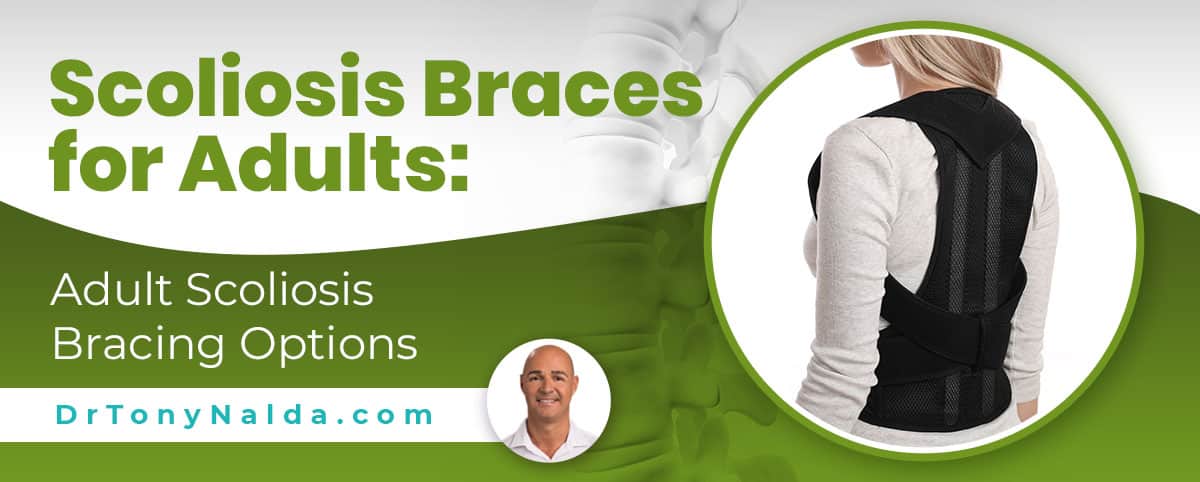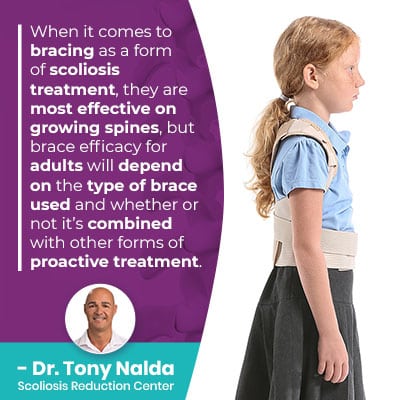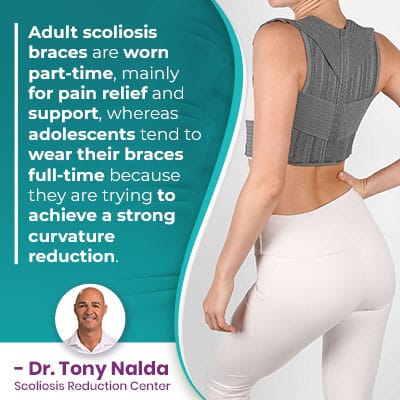Scoliosis Braces for Adults: Adult Scoliosis Bracing Options

Although bracing for adult patients doesn’t focus as strongly on curve reductions as it does with young patients when integrated into a conservative treatment plan as one of the multiple condition-specific treatment disciplines, it can augment corrective results. Just as different treatment approaches offer patients different potential outcomes, different bracing options can achieve different things.
When combined with other forms of proactive treatment, corrective scoliosis braces for adults can help reduce the curve and hold it there. Adult scoliosis bracing options can also help with postural remodeling, spinal stabilization, and pain management, but not all braces are created equal.
When it comes to choosing a scoliosis brace for an adult, they can be effective if designed properly and combined with other forms of corrective treatment.
Adult Scoliosis
As scoliosis is far more prevalent in children and adolescents, many overlook how it affects adults.
The two most common types of scoliosis to affect adults are idiopathic and degenerative, so let’s talk briefly about each.
Adult idiopathic scoliosis cases are extensions of the condition’s most prevalent form: adolescent idiopathic scoliosis (AIS), diagnosed between the ages of 10 and 18.
 AIS isn’t always easy to detect, particularly in mild cases, so adolescents who don’t receive a diagnosis or treatment during adolescence have their conditions progress with time and maturity until scoliosis becomes compressive in adulthood.
AIS isn’t always easy to detect, particularly in mild cases, so adolescents who don’t receive a diagnosis or treatment during adolescence have their conditions progress with time and maturity until scoliosis becomes compressive in adulthood.
Scoliosis develops across a wide severity spectrum from mild to moderate and severe to very severe, and as a progressive condition, where a scoliosis is at the time of diagnosis is not indicative of where it will stay; only proactive treatment can counteract the condition’s progressive nature.
Mild AIS isn’t associated with functional deficits, nor is it commonly painful, and the postural changes it causes can be too subtle for anyone other than an expert to detect.
Scoliosis isn’t commonly painful in children and adolescents because the constant lengthening motion of a growing spine counteracts the compressive force of the scoliotic curve and its compression of the spine and its surrounding muscles and nerves that causes the majority of condition-related pain.
When skeletal maturity is reached in adulthood, the condition becomes painful, and pain is the number one reason adults come to see me for a diagnosis and treatment.
The next most common type of scoliosis to affect adults is degenerative, caused by natural age-related spinal degeneration. In most cases, it’s the intervertebral discs sitting between adjacent vertebrae that are the first spinal structures to feel the effects of spinal degeneration.
Women are more likely than men to develop degenerative scoliosis because of hormone and bone-density changes related to menopause.
When it comes to bracing as a form of scoliosis treatment, they are most effective on growing spines, but brace efficacy for adults will depend on the type of brace used and whether or not it’s combined with other forms of proactive treatment.
Do Traditional Scoliosis Braces Work for Adults?
There are two main scoliosis treatment approaches for patients to choose between, each with its own end goal and bracing preference: traditional and conservative.
A traditional scoliosis treatment approach doesn’t have a strategy for treating scoliosis while mild, so it waits until conditions progress to a certain point before introducing traditional bracing, which is associated with a number of shortfalls.
Of the traditional braces, the most commonly prescribed brace is the Boston brace, which only addresses scoliosis as a 2-dimensional condition, but because of the rotational component, it’s actually a 3-dimensional condition.
The design of the Boston has remained the same since the ‘70s, despite our growing understanding of the condition and bracing efficacy over the years; the Boston is mass-produced and works towards stopping progression by squeezing the spine unnaturally from the sides to force it into a corrective position, and functions just as a basic back brace.
Squeezing the spine, however, over time, can actually weaken it, and the Boston is also known to increase related postural deviation, and does not improve the spinal curve.
In addition to the shortcomings of the Boston brace itself, the traditional treatment approach as a whole also factors into whether or not traditional bracing can work for adults because it doesn't apply any other forms of treatment, plus you have to factor in the scoliosis brace cost, and it becomes not worth it for a traditional brace.
As mentioned, traditional treatment doesn’t have a plan for treating conditions until they’re severe, which is why patients are funneled toward spinal fusion surgery, and no one form of treatment alone can actually correct scoliosis.
When I say correct or corrective results, what I mean is reducing the unnatural spinal curve on a structural level because scoliosis is a structural spinal condition.
So a traditional scoliosis brace can’t work for scoliosis in terms of achieving corrective results and is more likely to help with providing some additional spinal support and short-term pain relief, but not all scoliosis braces are created equal.
Bracing Plus Conservative Treatment for Adults
 Traditional bracing doesn’t address scoliosis as 3-dimensional, nor does it integrate other treatment disciplines into a plan, but there is also modern corrective bracing that has a different design, end-goal and complements other forms of treatment.
Traditional bracing doesn’t address scoliosis as 3-dimensional, nor does it integrate other treatment disciplines into a plan, but there is also modern corrective bracing that has a different design, end-goal and complements other forms of treatment.
Under a conservative chiropractic-centered treatment approach, scoliosis treatment starts as close to the time of diagnosis as possible; it doesn’t need to wait for a condition or the spinal curve to reach a certain severity level and strives, instead, to prevent increasing condition severity through proactive treatment.
Here at the Scoliosis Reduction Center, I customize each and every treatment plan to address key patient/condition variables, and modern corrective bracing, when combined with other forms of treatment, can help augment corrective results in my adult patients.
The focus of bracing, and treatment in general, in adolescent scoliosis is to achieve as strong a reduction as possible, whereas with adults, as they are not at risk for rapid-phase progression, the treatment focus is to reduce a curvature back to where it was prior to causing noticeable symptoms, pain management, and stabilizing the spine.
Adult scoliosis braces are worn part-time, mainly for pain relief and support, whereas adolescents tend to wear their braces full-time because they are trying to achieve a strong curvature reduction.
Adults with scoliosis have several bracing options, including the Milwaukee scoliosis brace and TLSO brace, which can be prescribed by doctors who specialize in treating scoliosis to help manage and alleviate the condition's effects.
Here at the Center, to meet my patients’ bracing needs, I opt for the ultra-corrective modern ScoliBrace, which represents the culmination of what we’ve learned about bracing efficacy over the years.
When combined with chiropractic care, in-office therapy, and custom-prescribed home exercises, scoliosis braces for adults can have corrective potential.
ScoliBrace for Adults
The ScoliBrace is an ultra-corrective modern scoliosis brace with correction as its end goal. The adult ScoliBrace is an adult-specific brace that focuses on spinal stabilization and postural realignment.
The ScoliBrace uses state-of-the-art scanning technology to ensure that each brace is customized to suit a patient’s body and condition type.
Instead of squeezing the spine unnaturally, the ScoliBrace pushes it into a corrective position, and because it addresses the true 3-dimensional nature of scoliosis, when combined with other forms of proactive treatment, it can augment corrective results.
The adult ScoliBrace is effective for both idiopathic and degenerative scoliosis, and as scoliosis affects adults differently in terms of pain, its design is based on treating the curve and improving pain through improving posture and stabilizing the spine.
Adults generally only have to wear the ScoliBrace part-time each day to see results in postural alignment and pain management.
The Adult ScoliBrace is designed around the unique challenges of treating adult scoliosis, and as it easily opens and closes in the front, it’s wearer-friendly, and due to the customization of braces to suit a patient’s body type, it’s a more comfortable and discreet brace to wear.
To summarize, the adult ScoliBrace can help with scoliosis by:
- Facilitating postural realignment
- Helping with stabilizing unstable segments of the spine
- Reducing pain
- Cosmetic results: improving postural deviation through postural correction
- Promoting optimal upright balance for fall prevention
- Helping slow/stop progression
So while the traditional Boston brace is known for a number of shortcomings, including its 2-dimensional approach and 3-point pressure system squeezing the spine unnaturally, the ScoliBrace offers an adult brace option with corrective potential.
Conclusion
When dealing with severe scoliosis, adults often explore scoliosis braces as a non-surgical solution to manage their condition.
Understanding scoliosis braces is essential for adults looking to fix scoliosis without surgery. There are various adult scoliosis bracing options available, offering non-invasive approaches to manage this condition effectively.
These braces for adults are specially designed to help fix scoliosis without surgery, providing support and attempting to halt the progression of the curvature. In cases where kyphosis is also present, a kyphosis brace may be integrated or chosen to address both spinal deformities concurrently.
While scoliosis is considered largely an adolescent condition, it also affects adults in the form of idiopathic or degenerative scoliosis.
Adults recently diagnosed with scoliosis have an important decision to make: how to treat it moving forward.
The traditional surgical approach relies solely on one form of treatment, traditional bracing, to treat scoliosis before recommending spinal fusion surgery, and traditional bracing is limited in its potential efficacy.
The ScoliBrace, however, is the brace of choice for conservative scoliosis treatment providers, featuring a modern design that addresses the shortcomings associated with traditional bracing through customization, addressing the condition’s true 3-dimensional nature, pushing vs squeezing the spine, helping to improve posture, and further stabilizing the spine.
So adult scoliosis bracing options include a traditional brace like the Boston, which can help with pain management and support, or a corrective brace like the adult ScoliBrace: designed specifically around the complexities of treating adult scoliosis for corrective results.
Dr. Tony Nalda
DOCTOR OF CHIROPRACTIC
After receiving an undergraduate degree in psychology and his Doctorate of Chiropractic from Life University, Dr. Nalda settled in Celebration, Florida and proceeded to build one of Central Florida’s most successful chiropractic clinics.
His experience with patients suffering from scoliosis, and the confusion and frustration they faced, led him to seek a specialty in scoliosis care. In 2006 he completed his Intensive Care Certification from CLEAR Institute, a leading scoliosis educational and certification center.
About Dr. Tony Nalda
 Ready to explore scoliosis treatment? Contact Us Now
Ready to explore scoliosis treatment? Contact Us Now





